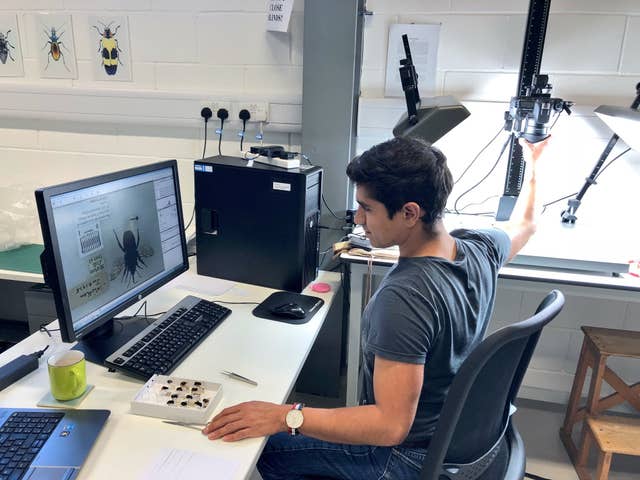
Bees have become increasingly stressed by climate change over the past 100 years, museum collections indicate.
An analysis of bumblebee wings from a network of UK institutions shows signs of stress linked to conditions getting hotter and wetter.
As well as revealing what is linked to stress in bees in the past, the study can help predict when and where bees will face most stress and potential decline in the future, researchers suggest.
Scientists from Imperial College London and the Natural History Museum have published two papers analysing UK bumblebee populations.
The first investigated the body shapes of bee specimens dating back to 1900.
Using digital images, researchers looked at asymmetry in bumblebee wings as an indicator of stress.
High asymmetry – very differently shaped right and left wings – indicated the creatures experienced stress during development – an external factor that affected their normal growth.
Looking at four UK bumblebee species, the group found evidence of stress getting higher as the century progressed from its lowest point around 1925.
Further analysis, published in the Journal of Animal Ecology, showed that each species displayed a consistently higher proxy of stress in the latter half of the century.
When assessing the climate conditions during the year of collection, the team found that in hotter and wetter years bees showed higher wing asymmetry.
Co-author Aoife Cantwell-Jones, from the department of life sciences (Silwood Park) at Imperial College London, said: “By using a proxy of stress visible on the bee’s external anatomy and caused by stress during development just days or weeks before, we can look to more accurately track factors placing populations under pressure through historic space and time.”
Co-author Dr Andres Arce, now at the University of Suffolk, added: “Our goal is to better understand responses to specific environmental factors and learn from the past to predict the future.

“We hope to be able to forecast where and when bumblebees will be most at risk and target effective conservation action.”
Senior co-author Dr Richard Gill, also from Imperial, said: “With hotter and wetter conditions predicted to place bumblebees under higher stress, the fact these conditions will become more frequent under climate change means bumblebees may be in for a rough time over the 21st century.”
In a second study, published in Methods in Ecology & Evolution, the team successfully sequenced the genomes of more than a hundred bumblebee museum specimens dating back more than 130 years.
They used methods typically used for studying woolly mammoths and ancient humans on an insect population for the first time.
As well as providing a new reference genome, the team will now use this data to study how bee genomes have changed over time, gaining an understanding of how whole populations have adapted – or not – to changing environments.
Co-author Dr Victoria Mullin, from the Natural History Museum, said: “Museum insect collections offer an unparalleled opportunity to directly study how the genomes of populations and species have been affected by environmental changes through time.
“However, they are a finite resource and understanding how best to utilise them for genetic studies is important.”


Why are you making commenting on The National only available to subscribers?
We know there are thousands of National readers who want to debate, argue and go back and forth in the comments section of our stories. We’ve got the most informed readers in Scotland, asking each other the big questions about the future of our country.
Unfortunately, though, these important debates are being spoiled by a vocal minority of trolls who aren’t really interested in the issues, try to derail the conversations, register under fake names, and post vile abuse.
So that’s why we’ve decided to make the ability to comment only available to our paying subscribers. That way, all the trolls who post abuse on our website will have to pay if they want to join the debate – and risk a permanent ban from the account that they subscribe with.
The conversation will go back to what it should be about – people who care passionately about the issues, but disagree constructively on what we should do about them. Let’s get that debate started!
Callum Baird, Editor of The National
Comments: Our rules
We want our comments to be a lively and valuable part of our community - a place where readers can debate and engage with the most important local issues. The ability to comment on our stories is a privilege, not a right, however, and that privilege may be withdrawn if it is abused or misused.
Please report any comments that break our rules.
Read the rules hereLast Updated:
Report this comment Cancel